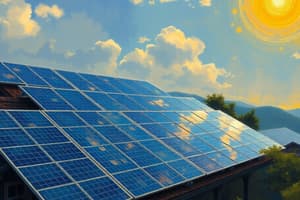Podcast
Questions and Answers
Was ist die Bedeutung des Begriffs 'Photovoltaik'?
Was ist die Bedeutung des Begriffs 'Photovoltaik'?
- Wärme-Licht
- Elektrizität-Licht
- Licht-Wärme
- Licht-Elektrizität (correct)
Wie laufen die Elektronen frei, wenn Photonen in eine photovoltaische Zelle eindringen?
Wie laufen die Elektronen frei, wenn Photonen in eine photovoltaische Zelle eindringen?
- Sie bleiben in ihrem ursprünglichen Zustand
- Sie werden in einen höheren Energiezustand angeregt (correct)
- Sie werden von den Photonen absorbiert
- Sie werden von der Zelle abgestoßen
Was ist das fundamentale Bauteil eines PV-Systems?
Was ist das fundamentale Bauteil eines PV-Systems?
- Trägerstruktur
- Solarpanel
- Photovoltaische Zelle (correct)
- Elektrokabel
Was geschieht, wenn mehr Licht von einer photovoltaischen Zelle absorbiert wird?
Was geschieht, wenn mehr Licht von einer photovoltaischen Zelle absorbiert wird?
Wozu dienen Solarpanele?
Wozu dienen Solarpanele?
Wann wurde der photovoltaische Effekt zum ersten Mal erwähnt?
Wann wurde der photovoltaische Effekt zum ersten Mal erwähnt?
Was ist ein wesentlicher Vorteil von Photovoltaik?
Was ist ein wesentlicher Vorteil von Photovoltaik?
Was ist ein Bestandteil eines typischen Photovoltaik-Systems?
Was ist ein Bestandteil eines typischen Photovoltaik-Systems?
Was ist ein aktuelles Forschungsgebiet in der Photovoltaik?
Was ist ein aktuelles Forschungsgebiet in der Photovoltaik?
Wozu dienen Montagestrukturen in einem Photovoltaik-System?
Wozu dienen Montagestrukturen in einem Photovoltaik-System?
Was ist ein Vorteil von Photovoltaik-Systemen?
Was ist ein Vorteil von Photovoltaik-Systemen?
Was ist ein alternativer Werkstoff zu Silizium in Solarzellen?
Was ist ein alternativer Werkstoff zu Silizium in Solarzellen?
Study Notes
Photovoltaics: Harnessing the Sun's Energy
Photovoltaics, often referred to as PV, is a critical area of research and development in the field of sustainable energy. It involves the direct conversion of light into electrical power using semiconducting materials such as silicon. This phenomenon, known as the photovoltaic effect, has been studied extensively in physics and chemistry since its first mention around 1890.
The Basics of Photovoltaics
The term photovoltaics combines the Greek words 'photo' (light) and 'volt' (electricity), literally meaning "light-electricity." This describes the process where light is converted into electricity. Solar panels are a practical application of this phenomenon, supplying green power for homes and industries.
The photovoltaic cell is the fundamental component of a PV system. When photons of light penetrate a photovoltaic cell, they can excite electrons to a higher energy state. These free electrons can then be captured, resulting in an electric current that can be used to produce electricity.
The more light absorbed by a photovoltaic cell, the more electricity is produced. This allows for the conversion of solar energy into electricity, providing an alternative to traditional energy sources like fossil fuels.
Solar Panels and Photovoltaic Systems
Solar panels are made by connecting several solar cells together within a supporting structure. These cells can be connected in series or parallel to create photovoltaic modules, which can then be combined to form a photovoltaic system.
A typical photovoltaic system includes the solar panels themselves, plus mounting structures that help the panels face the sun, as well as components that convert the direct-current (DC) electricity produced by the panels into the alternating-current (AC) electricity used by household appliances.
The Benefits of Photovoltaics
One of the primary benefits of photovoltaics is its sustainability. Unlike fossil fuels, solar energy is renewable and has no harmful impact on the environment. Additionally, solar panels and photovoltaic systems provide green power for homes and industries, potentially allowing for independence from fossil fuels.
Photovoltaic technology is modular, allowing for PV systems to be built to meet a wide range of electric power needs, from small residential installations to large utility-scale projects.
Advancements in Photovoltaics
Researchers are continually exploring ways to improve the efficiency and cost-effectiveness of photovoltaics. For example, perovskite-based photovoltaics are a promising alternative to traditional silicon cells, with the potential to match their output at a lower cost.
Integrated thermo-photovoltaic cells that can simultaneously produce heat and electricity are another area of active research.
In summary, photovoltaics is a crucial field in the pursuit of sustainable energy. The technology allows for the conversion of solar energy into electricity, providing a renewable and environmentally friendly alternative to fossil fuels. Ongoing research and development aim to improve the efficiency, cost, and versatility of photovoltaics, making it a key player in the transition to a sustainable energy future.
Studying That Suits You
Use AI to generate personalized quizzes and flashcards to suit your learning preferences.
Description
Photovoltaik ist ein wichtiger Bereich in der Forschung und Entwicklung nachhaltiger Energie. Dieser Quiz behandelt die Grundlagen der Photovoltaik, wie sie funktioniert und ihre Vorteile. Erfahren Sie mehr über die Umwandlung von Sonnenlicht in elektrische Energie.




